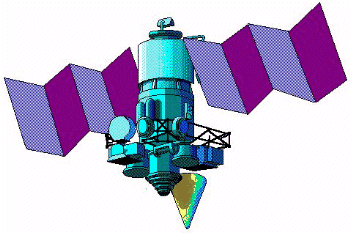
Meteor-2-21/FIZEAU
Jump to: Mission Objectives, Mission Instrumentation, Mission Parameters, Additional Information
Mission Photos:

Courtesy of SPUTNIK Server
Mission Objectives:
Meteor 2-21 is the twenty-first and last in the Meteor-2 series of Russian meteorological satellites launched in 1993. The Meteor satellites were designed to monitor atmospheric and sea-surface temperatures, humidity, radiation, sea-ice conditions, snow-cover, and clouds.
What makes Meteor 2-21 distinctive from the other meteorological satellites is its unique retroreflector array. Fizeau is named after a French physicist, Armand Fizeau, who in 1851 conducted an experiment which tested for the aether convection coefficient. SLR tracking of this satellite was used for precise orbit determination and the Experiment of Fizeau. The Fizeau Experiment tests the theory of special relativity-that distance events that are simultaneous for one observer will not be simultaneous for an observer in motion relative to the first.
Mission Instrumentation:
Meteor-2-21/Fizeau had the following instrumentation onboard:
- Scanning telephotometer
- Scanning infrared radiometers
- Radiation measurement complex
- Retroreflector array
Mission Parameters:
| Sponsor: | Russia |
| Expected Life: | 1-2 years |
| Primary Applications: | weather monitoring |
| Primary SLR Applications: | retroreflector technology |
| COSPAR ID: | 9305501 |
| SIC Code: | 5050 |
| Satellite Catalog (NORAD) Number: | 22782 |
| Launch Date: | May 31, 1993 |
| RRA Diameter: | unknown |
| RRA Shape: | linear array |
| Reflectors: | 3 corner cubes |
| Orbit: | circular |
| Inclination: | 82.6 |
| Eccentricity: | 0.002 |
| Perigee: | 950 km |
| Period: | 104 minutes |
| Weight: | 1300 kg |
Additional Information:
Web sites:
Publications:
- Vassiliev, V., Gusev, L., Degnan, J., and Shargorodsky, V., "Experimental Verification of the Fizeau Effect Influence on the Reflected Beam Direction in Satellite Laser Ranging", Proc. of the 9th International Workshop on Laser Ranging Instrumentation, Australian Government Publishing Service, Canberra, p . 147, 1994.




